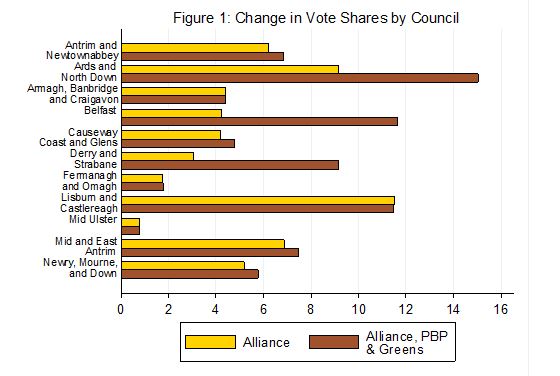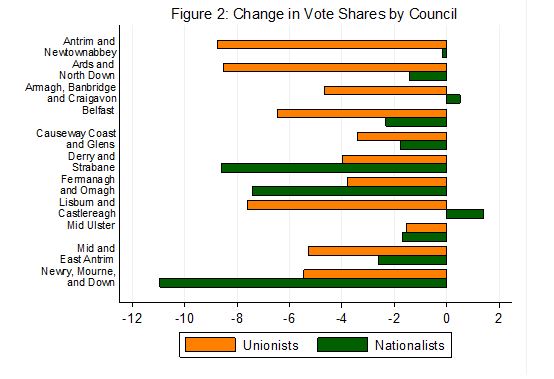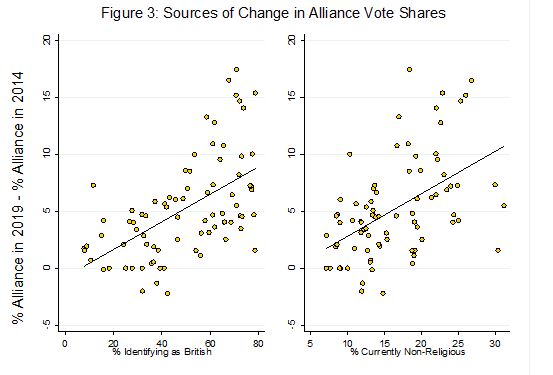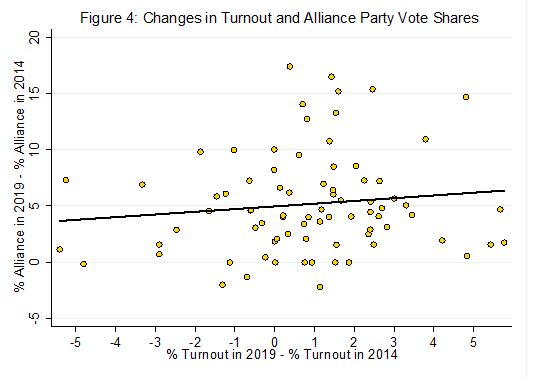The 2019 Local Elections: A Signal of Changes Still to Come?
Dr Christopher Raymond looks at the recent local council elections in Northern Ireland, in particular the growing trend in favouring ‘Other’designated parties.

What was meant to be a sleepy affair returning the same sets of actors to local councils turned out to be a lot more interesting. The Alliance and other parties with cross-community appeals turned out (even) better-than-expected performances in several local council elections, continuing a trend for these parties towards increased prominence in elections and government in Northern Ireland. While one should not overstate the degree to which Thursday’s elections altered the appearance of Northern Ireland’s party system, the results elevate questions about the impact of demographic and social changes on elections going forward.
Big Gains for ‘Other’ Parties
The big winners were the Alliance Party, whose vote and seat gains put them on nearly-level pegging with the SDLP and UUP. Although the party made gains across all 11 councils, the gains were more dramatic on some councils than others. Figure 1 shows the increases in the party’s vote shares were particularly great in Lisburn and Castlereagh, Ards and North Down, Mid and East Antrim, and Antrim and Newtownabbey councils. While the Greens also gained votes and seats on several councils, as did People Before Profit in Belfast and Derry and Strabane, most of the vote-share gains among the ‘Other’-designated parties was due to the increased shares won by the Alliance Party.

The gains made by the smaller parties came at the expense of unionist and nationalist parties. Figure 2 shows the largest losses by unionist parties were in councils where the Alliance picked up the most support (with further losses to the Greens in Belfast as well). While the DUP managed to increase its first-preference vote share, the decline in the broader unionist vote will undoubtedly continue discussions about divisions among unionist parties given demographic trends with potential to reduce these parties’ vote shares further.
Losses by the two main nationalist parties will fuel continued internal policy debates on social and economic issues as well, though the declines in these parties’ vote shares owed less to inroads made by the Alliance and more to competition from People Before Profit, independent candidates, and to a lesser extent, Aontú.

To understand the reasons for the uneven gains made by the Alliance Party, it helps to break the results down by district electoral area (DEA). Figure 3 shows the DEAs where the Alliance Party made its biggest gains. On one hand, we see that the Alliance Party tended to make larger gains in DEAs with more voters identifying as British. This finding is in keeping with arguments that some unionists felt comfortable voting for the Alliance Party because the stakes to the union are lower in local elections than they are in Westminster or Assembly elections.

However, we also see that the Alliance Party made gains in DEAs with more non-religious voters, suggesting that the party won over more of these voters. This suggests that the Alliance Party is poised to make additional gains among the growing body of voters who do not identify as religious—and who identify as neither unionist nor nationalist.
Further analysis reveals that the Greens and People Before Profit similarly made gains in less-religious DEAs, suggesting that the increasing secularisation of society will lead to even higher vote shares for ‘Other’-designated parties in future elections.
The Impact of Turnout?
One question raised by these elections was whether the success of the Alliance and other smaller parties was due to increased turnout in the areas where these parties fared best. Rather than a change in voters’ behaviour between the two elections, this argument suggests the Alliance performed better in 2019 as new groups of voters turned out to vote (while voters who supported unionist or nationalist parties in 2014 stayed home). To an extent, this may have been true, as turnout was up slightly, with 52.7 per cent of the electorate turning out in 2019, compared to 51.9 per cent in 2014.
However, analysing the relationship between changes in turnout and changes in party support provides little evidence to suggest that the gains made by the Alliance were due to changes in turnout. Figure 4 shows that changes in vote shares for the Alliance Party were unrelated in any systematic way to changes in turnout. (Similar findings emerge when looking at the Green Party’s vote shares.) Though the Alliance Party saw its vote shares increase in some DEAs where turnout increased, the party’s vote shares also increased in DEAs where 2019 turnout was lower than in 2014.

More importantly, Figure 4 shows that the increases in turnout were exceeded by the increases in the party’s vote shares. Even if we assume every voter reflected in the increased percentage turning out in 2019 voted for the Alliance Party as their first preference (a difficult but not impossible proposition), the fact the increased vote shares for the Alliance Party exceeded the increases in turnout means that other voters who turned out in 2014 switched their first-preference votes to the Alliance Party in 2019. Keeping in mind that the party fared better in DEAs with more non-religious voters and voters identifying as British, this implies that many voters supporting unionist parties in 2014 switched to support the Alliance Party.
Looking Forward
The 2019 local elections continued a trend towards larger vote and seat shares for ‘Other’-designated parties, particularly the Alliance Party. These trends seem to reflect broader social and demographic changes in the electorate, as reflected in the fact the Alliance and others continue to make gains among voters who are increasingly uninterested in voting along unionist-nationalist lines—and who constitute a growing share of the population.
Although it is too early to tell whether the recent trends favouring ‘Other’-designated parties constitute a long-term problem for the major unionist and nationalist parties, we will have another test of the supposed impact of social and demographic changes on smaller parties’ support in two weeks’ time.
The featured image in this article has been used thanks to a Creative Commons licence




